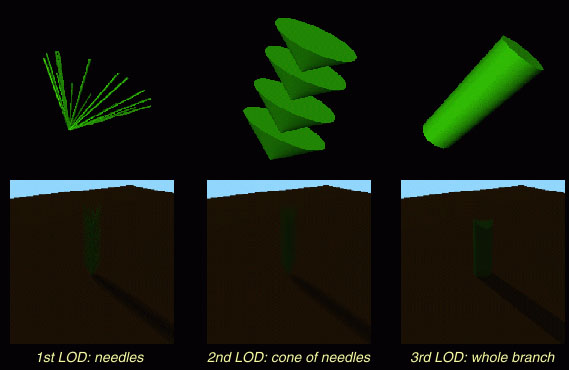Trees

 This demonstration shows a method for accelerating the realistic
rendering in ray-tracing of forests of pine-trees.
This demonstration shows a method for accelerating the realistic
rendering in ray-tracing of forests of pine-trees.
As for many complex materials (hair, fur, fabric, cristals), pine-tree
needles have an effect in the tree illumination even if their small size
seems to be geometrically neglectable.
The classical level of detail approaches consisting in replacing several small
entities by a large single one thus destroy important information. The
contribution of each needle should not be lost, but at the same time,
dealing with each of the billion of needles of the scene individually is
not affordable and would yield an untractable rendering time and a strong
aliasing.
Our approach consists in derivating reflectance functions, or shaders,
which analytically integrates the luminous contributions (reflects,
shadows, opacity) of a set of needles. Depending of the distance, this
`set' corresponds to one needle, a cone of needles, or a whole
branch. This corresponds to three different levels of details, which have
the same behavior as a bough of needles.
We can now compute very complex scenes like the one below (~10 000 000 needles). Using cone tracing algorithm, computation time
decreases dramatically to approximately 10 minutes, that's to say ten
times quicker than classical ray-tracing systems, with a better image
quality.

For further details: http://www-evasion.imag.fr/Publications/2000/MN00/
Contacts: Alexandre.Meyer@imag.fr - Fabrice.Neyret@imag.fr

 This demonstration shows a method for accelerating the realistic
rendering in ray-tracing of forests of pine-trees.
This demonstration shows a method for accelerating the realistic
rendering in ray-tracing of forests of pine-trees.

